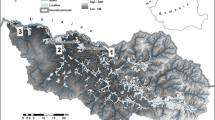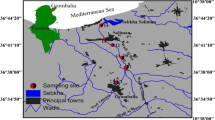Abstract—
The composition and content of hydrocarbons (HCs) in the waters three raised bogs of the south taiga subzone of Western Siberia: the Bolshoe bog, Central bog, and Bakchar bog (which is part of the Great Vasyugan mire) were determined by IR spectrometry, fluorimetry, and chromatography–mass spectrometry. The waters of the bogs are demonstrated to contain hydrocarbons coming from peat deposits (and produced by plants) and pyrogenic hydrocarbons. The Bolshoe bog, which occurs near areas with oil-producing facilities, is the only one whose water contains oil hydrocarbons. The most representative HCs group is n-alkanes whose carbon preference index (CPI) is 4.9–9.2. Among alicyclic HCs, the highest concentrations were detected for triterpenes, with the dominance of taraxerene and neohop-13(18)-ene in the Bolshoe and Bakchar bogs and diploptene in the Central bog. Contamination with oil hydrocarbons, which are transferred by air from oil- and gas-producing facilities, was identified based on the presence of methyl-substituted polycyclic aromatic hydrocarbons (PAHs), steranes, hopanes, and cheilanthanes and by reduced CPI in the water of the Bolshoe bog. The effect of fires in 2016 is inferred from the ratios of unsubstituted PAHs.



Similar content being viewed by others
REFERENCES
S. Dahle, V. M. Savinov, G. G. Matishov, A. Evenset, and K. Nas, “Polycyclic aromatic hydrocarbons (PAHs) in bottom sediments of the Kara Sea shelf, Gulf of Ob and Yenisei Bay,” Sci. Total Environ. 306 (1–3), 57–71 (2003).
B. M. Didyk, B. R. T. Simoneit, L. A. Pezoa, M. L. Riveros, and A. A. Flores, “Urban aerosol particles of Santiago, Chile: organic content and molecular characterization,” Atmos. Environ. 34, 1167–1179 (2000).
A. F. Diefendorf, K. H. Freeman, and S. L. Wing, “A comparison of terpenoid and leaf fossil vegetation proxies in Paleocene and Eocene Bighorn Basin sediments,” Org. Geochem. 71, 30–42 (2014).
M. A. Duchko, Extended Abstract of Candidate’s Dissertation in Chemistry (Tomsk, 2017)
N. S. Evseeva, Geography of the Tomsk Region. Natural Conditions and Resources (Tomsk. Univ., Tomsk, 2001) [in Russian]
K. J. Ficken, B. Li, D. L. Swain, and G. Eglinton, “An n‑alkane proxy for the sedimentary input of submerged/floating freshwater aquatic macrophytes,” Org. Geochem. 31, 745–749 (2000).
Fire Map http://fires.ru/
J. Golovko, R. P. Philp, G. Pevneva, and A. Golovko, “High-molecular n-alkanes in oils of West Siberia and Sakhalin Island,” Prog. Min. Oil. Chem. 2, 315–324 (2000).
Yu. A. Golovko, G. S. Pevneva, A. K. Golovko, and B. Jovancicevic, “Correlation of geochemical parameters on the composition of arenes and saturated hydrocarbons,” Prog. Min. Oil. Chem. 1, 183–190 (1999).
D. A. Golubeva and N. D. Sorokina, Environmental Protection, Nature Management, and Providing the Ecological Safety in St. Petersburg in 2007 (St. Petersburg, 2008) [in Russian].
K. A. Harris, M. B. Yunker, N. Dangerfield, and P. S. Ross, “Sediment–associated aliphatic and aromatic hydrocarbons in coastal British Columbia, Canada: Concentrations, composition, and associated risks to protected sea otters,” Environ. Pollut. 159, 2665–2674 (2011).
J. M. Hunt, Petroleum Geochemistry and Geology, 2nd Ed., Ed. by W. H. Freeman (San Francisco, 1996).
I. I. Lishtvan, E. T. Bazin, N. I. Gamayunov, and A. A. Terent’ev, Physics and Chemistry of Peat (Nedra, Moscow, 1989) [in Russian].
O. A. Liss, L. I. Abramova, N. A. Avetov, N. A. Berezina, L. I. Inisheva, T. V. Kurnishkova, and Z. A. Sluka, Swampy Systems of Western Siberia and their Environmental Significance (Grif and K, Tula, 2001) [in Russian].
M. Malawska, A. Ekonomiuk, and B. Wiłkomirski, “Polycyclic aromatic hydrocarbons in peat cores from southern Poland: distribution in stratigraphic profiles as an indicator of PAH sources,” Mires Peat 1, 1–14 (2006).
M. A. Mashinchian, A. H. Dashti, M. R. Fatemi, and A. P. Aberoumand, “Study of linear alkyl benzene (LABs) as molecular marker of sewage pollution in Bivalves Mollusk “AnodontaCygnea” in Anzali lagoon,” Int. J. Mar. Sci. Eng. 2 (2), 171–176 (2012).
O. Naymushina, S. Shvartsev, O. Serebrennikova, K. Ses, and I. Matveenko, “Spatial distribution of chemical and organic compounds in the water of oligotrophic peatland of Tomsk Region (Western Siberia),” Proc. Chem. 10, 541–546 (2014).
J. E. Ortiz, L. Moreno, T. Torres, J. Vegas, B. Ruiz-Zapata, Á. García-Cortés, L. Galán, and A. A. Pérez-González, “220 ka paleoenvironmental reconstruction of the Fuentillejo maar lake record (Central Spain) using biomarker analysis,” Org. Geochem. 55, 85–97 (2013).
K. E. Peters, C. C. Walters, and J. M. Moldowan, The Biomarker Guide: II. Biomarkers and Isotopes in Petroleum Systems and Earth History (Cambridge University Press, 2005) Vol. 2.
A. A. Petrov, Oil Hydrocarbons (Nauka, Moscow, 1984) [in Russian].
M. Razwan Sardar, Yi. Yang, and Yun Wei, “Origin of long chain alkylbenzenes in environmental and geological samples and their analysis with different chromatographic techniques,” Rev. J. Chem. 1 (3), 288–307 (2011).
SanPiN 2.1.5.980–00 “Hygienic Requirements to the Surface Water Protection (Fedederal. Ts. Gossanepidnadzor Minzdrava Rossii, Moscow, 2000) [in Russia].
O. V. Serebrennikova, Yu. I. Preis, P. B. Kadychagov, and E. V. Gulaya, “Hydrocarbon Composition of the Organic Matter of Peats in the South of Western Siberia,” Solid Fuel Chem. 44 (5), 324–334 (2010).
O. V. Serebrennikova, E. B. Strelnikova, Yu. I. Preis, and M. A. Duchko, “Influence of peat formation conditions on the transformation of peat deposit organic matter,” IOP Conf. Series: Earth Environ. Sci. 27(1), 012036 (2015).
O. Serebrennikova, E. Strelnikova, Y. Preis, M. Duchko, I. Rousskikh, P. Kaduchagov, and A. Peresedova, “The composition of biologically active compounds in peat from different climatic zones of Western Siberia,” MATEC Web of Conf. 85, art, 01 006 (2016).
O. V. Serebrennikova, E. B. Strel’nikova, I. V. Russkikh, Ju. I. Preis, and M. A. Duchko, “Chemical composition of lipids from peat–forming leafy mosses of eutrophic swamps of Western Siberia and Altai,” Russ. J. Bioorg. Chem. 43 (7), 70–75 (2017a).
O. V. Serebrennikova, E. B. Strel’nikova, I. V. Russkikh, and M. A. Duchko, “Composition of the lipids of the sphagnum and cotton grass peats in the forest steppe and southern and middle taigas of West Siberia,” Solid Fuel Chem. 51 (4), 195–204 (2017b).
O. V. Serebrennikova, E. B. Strel’nikova, I. V. Russkikh, Yu. I. Preis, and N. V. Kozel, “Influence of growth conditions on the composition of lipids of sphagnum and green moss,” Swamp Vegetation: Modern Problems of Classification, Mapping, Use, and Protection. Proceedings of 3rd International Seminar, Minsk–Grodno, Belarus,2018 (Kolorgrad, Minsk, 2018), pp. 119–123.
O. V. Serebrennikova, M. A. Duchko, N. G. Koronatova, and E. B. Strel’nikova, “Concentrations and composition of sphagnum peat lipids depending on temperature in the climatic zones of Western Siberia,” Solid Fuel Chem. 52 (1), 36–43 (2018a).
O. V. Serebrennikova, I. V. Russkikh, E. B. Strelnikova, Yu. A. Kharanzhevskaya, and E. S. Voistinova, “Composition and Sources of dissolved organic matter of bog waters in the southern taiga of Western Siberia,” AIP Publish. J. 2051, 020271 (2018b).
L. I. Svarovskaya, O. V. Serebrennikova, M. A. Duchko, E. B. Strel’nikova, and I. V. Russkikh, “Changes in the composition of the bituminous components of valley peat under stimulated microbial action,” Solid Fuel Chem. 51 (2), 67–77 (2017).
K. D. Tapan, “Origin, occurrence, and biodegradation of long–side–chain alkyl compounds in the environment: a review,” Environ. Geochem. Health27 (3), 271–284 (2005).
B. P. Tissot and D. H. Welte, Petroleum Formation and Occurrence (Springer-Verlag. Berlin–Heidelberg–New York–Tokyo, 1984).
B. V. Tsombueva, Extended Abstract of Candidate’s Dissertation in Chemistry (Kalmytsk. Gos. Univ., Elista, 2016).
R. Vacha, J. Čechmankova, and J. Skala, “Polycyclic aromatic hydrocarbons in soil and selected plants,” Plant soil environ. 56, 435 (2010).
V. I. Viershinin, T. V. Antonova, and M. A. Fedorova, “Reliability of integra; indicators as estimates of the total contents of hydrocarbons and phenols in natural and sewage waters: a review,” Zavod. Laboratoriya. Diagnost. Material. 79 (10), 3–12 (2013).
E. S. Voistinova, Yu. A. Kharanzhevskaya, and A. A. Sinyutkina, “Peculiarities of hydrochemical mode of the northeastern Vasyugan mire in the Bakchar–Iksa interfluves (Western Siberia),” Vodnoye khozyaystvo, No. 3, 16–34 (2018).
E. Y. Zeng, D. Cheng, A. R. Khan, and C. L. Vista “Validity of using linear alkylbenzenes as markers of sewage contamination with interference from tetrapropylene-based alkylbenzenes,” Environ. Toxicol. Chem. 17, 394–397 (1998).
Z. Zhanga, M. Zhaob, G. Eglinton, H. Lud, and C. Huange, “Leaf wax lipids as paleovegetational and paleoenvironmental proxies for the Chinese Loess Plateau over the last 170 kyr,” Quat. Sci. Rev. 25, 575–594 (2006).
Norms of Quality of Fishery Waters, Including Norms of Maximally Permissible Concentrations of Toxic Matters in Fishery Waters (2010). Approved by of Head of Federal Fishery Agency, A. A. Krainii, Order no 20 of January 18, 2010, registered by the Ministry of Justice by February 9, No. 16326.
Funding
The study was funded by the Ministry of Science and Higher Education of the Russian Federation (project V.46.1.2), sample processing (project 0778-2019-0005), field research were funded by the Russian Foundation for Basic Research, project no. 18-44-700005.
Author information
Authors and Affiliations
Corresponding authors
Additional information
Translated by E. Kurdyukov
Rights and permissions
About this article
Cite this article
Russkikh, I.V., Strel’nikova, E.B., Serebrennikova, O.V. et al. Identification of Hydrocarbons in the Waters of Raised Bogs in the Southern Taiga of Western Siberia. Geochem. Int. 58, 447–455 (2020). https://doi.org/10.1134/S0016702920040072
Received:
Revised:
Accepted:
Published:
Issue Date:
DOI: https://doi.org/10.1134/S0016702920040072




